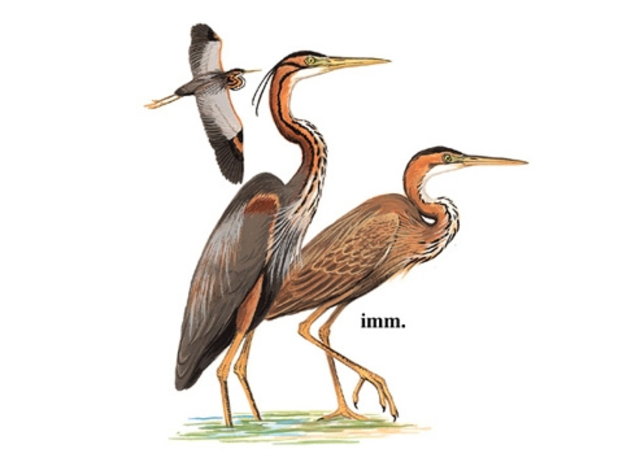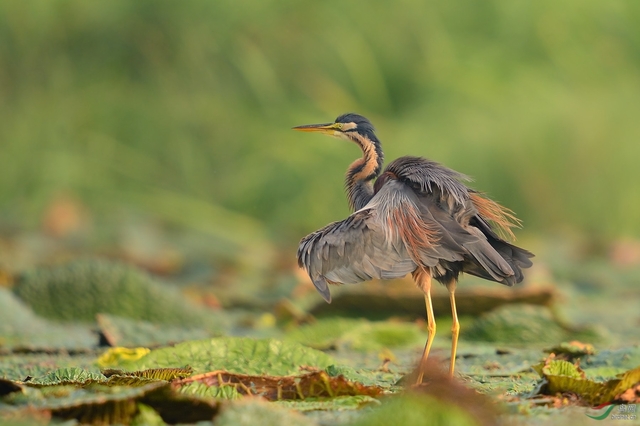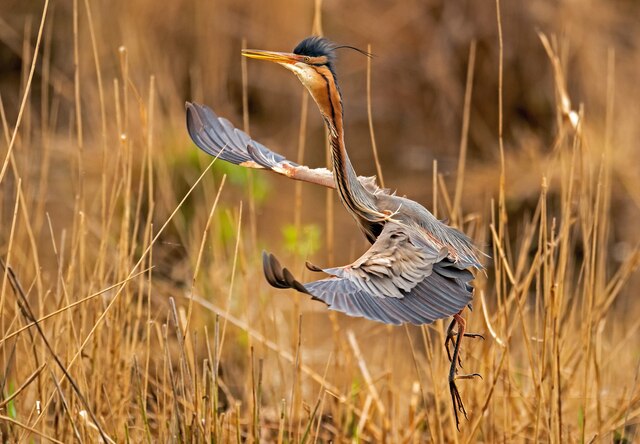Ardea purpurea
IUCN
LCBasic Information
Scientific classification
- name:Ardea purpurea
- Scientific Name:Purple Heron、Purple heron, flower cellar horse, wood heron, long-necked heron
- Outline:Wading birds
- Family:A.purpurea
Vital signs
- length:78—97 cm
- Weight:0.5 to 1.35 kg
- lifetime:25 years
Feature
A large wading bird with the characteristics of "three lengths", namely a long beak, a long neck, and long legs.
Distribution and Habitat
Distributed in Afghanistan, Albania, Algeria, Angola, Armenia, Austria, Azerbaijan, Bahrain, Bangladesh, Belarus, Belgium, Benin, Bosnia and Herzegovina, Botswana, Brunei, Bulgaria, Burkina Faso, Burundi, Cambodia, Cameroon, Cape Verde, Central African Republic, Chad, China, Congo, Côte d'Ivoire, Croatia, Cyprus, Czech Republic, Djibouti, Egypt, Eritrea, Ethiopia, France, Gabon, Gambia, Georgia, Germany, Ghana, Gibraltar, Greece, Guinea, Guinea-Bissau, Hungary, India, Indonesia, Iran, Iraq, Israel, Italy, Japan, Jordan, Kazakhstan, Kenya, South Korea, North Korea, Kuwait, Kyrgyzstan, Lao People's Democratic Republic, Lebanon, Lesotho, Libya, Liechtenstein, Macedonia, Madagascar, Malawi, Malaysia, Maldives, Mali, Malta, Mauritania, Moldova, Montenegro, Morocco, Mozambique, Myanmar, Namibia, Nepal, Netherlands, Niger, Nigeria, Oman, Pakistan, Palestine, Philippines, Poland, Portugal, Qatar, Romania, Russian Federation, Rwanda, Saudi Arabia, Senegal, Serbia, Seychelles, Sierra L
Appearance
The body color is mainly chestnut, the crown is black with two braided feathers, the neck is chestnut brown, the sides of the neck have black vertical stripes, the lower part of the neck has white feathers, the upper body is gray, the flight feathers are black, the shoulder feathers are reddish brown, the iris is yellow, the beak is yellow, and the feet are yellow.
Details

Ardea purpurea is a species of heron in the Ardeidae family. It is also known as purple heron, commonly known as flower cellar horse, wood heron or long-necked man. It is a widely distributed heron. They breed in Africa, central and southern Europe, and the southern and eastern Palearctic. Populations in the western Palearctic migrate between breeding and wintering grounds, while populations in Africa and tropical Asia are mainly resident birds, except for occasional scattered movements.
They are a large wading bird with the characteristics of "three longs", namely long beak, long neck and long legs. They are similar in appearance to the more common heron, but slightly smaller, more slender, and with darker plumage. They are also more shy birds, preferring densely planted habitats near water, especially reed marshes. They prey on a variety of prey including fish, rodents, frogs and insects, either stalking them or standing in ambush when hunting.
The heron breeds in colonies and builds a bulky nest made of dead reeds or branches in reed beds or dense vegetation near water. It lays about five blue-green eggs, which are incubated alternately by the male and female parents. The chicks hatch after about four weeks and leave the nest after another six weeks. The International Union for Conservation of Nature notes that the global population trend of the heron is declining, mainly due to the drainage of wetlands, but assesses the conservation status of the heron as "Least Concern".

The heron is a large bird, with a length of 78–97 cm (31–38 in), a standing height of 70 to 94 cm (28 to 37 in), and a wingspan of 120–152 cm (47–60 in). However, it is slender and weighs only 0.5 to 1.35 kg (1.1 to 3.0 lb). It is slightly smaller than a heron and can be distinguished by its darker reddish-brown plumage and darker grey back in adults. The forehead and top of the head of the adult are black, with a black stripe on the nape terminating in a slender, drooping crest. This crest is shorter than that of a heron, no more than 140 mm (5.5 in). The head and sides of the neck are tawny, with darker stripes and lines on the sides of the neck. The back is oily brown, with the upper shoulder feathers extended but not the lower shoulder feathers. The rest of the upper parts and the tail are brownish grey. The front of the neck is lighter than the sides, with some extended feathers at the base of the neck, with white, brown and black stripes. The breast is brown with some black on the sides, and the belly and undertail coverts are black. The tan bill is long and straight, and the color becomes brighter in adults during the breeding season. The iris is yellow, and the legs are brown in front and tawny behind.
The body is spindle-shaped. The forehead and top of the head are blue-black, and there are two black braided feathers on the nape; there is a black stripe on the cheek, and there is also a clear black vertical stripe extending down on the side of the neck. Intermittent and scattered short black vertical stripes can also be seen on the front neck; the upper body is gray, the flight feathers on both wings are gray-black, and the wing corners and front edges of the wings are brown-chestnut; the chin and throat are white, and there are silver-gray or white long spear-shaped feathers at the base of the front neck; the central base of the chest and upper abdomen is brown-chestnut, the tip is blue-black, the lower abdomen is blue-black, and the flanks are gray; the iris is yellow, the bill is dark yellow, the corner of the bill is brown, and the exposed part before the eyes is yellow-green.
Size measurements: Weight ♂ 775-1250 g, ♀ 1075-1160 g; Body length ♂ 830-970 mm, ♀ 840-970 mm; Bill ♂ 105-130 mm, ♀ 109-130 mm; Wings ♂ 370-379 mm, ♀ 348-390 mm; Tail ♂ 118-140 mm, ♀ 110-136 mm; Tarsus ♂ 112-135 mm, ♀ 115-145 mm. (Note: ♂ male; ♀ female)
Its call is a rough "frarnk", but quieter and higher pitched than that of a heron. It is generally a less noisy bird, although a similar guttural sound can be heard from herons. It is also less muscular and appears to have a slightly sunken chest. Its head and neck are more slender than those of a heron, with a greater serpentine curve and longer toes. Unlike a heron, it often adopts a posture with its neck extended, a position even used by chicks.
The heron is found mainly in the Palearctic, breeding in Europe, Asia, and Africa. The western race's range extends eastward from Portugal across most of central and southern Europe and part of North Africa to Lake Balkhash in Kazakhstan. In Africa, the bird breeds in Senegal, along the east coast of Africa, and in Madagascar. The eastern race extends eastward from the Indian subcontinent to eastern China and the Philippines, and northward to the Amur and Ussuri River basins, about 49 degrees north latitude. The southern race is confined to Madagascar, with a small population of herons in the Cape Verde Islands considered a separate race by some authorities.
Birds of the western race migrate south to tropical Africa from August to October each year, returning north in March. Herons often return beyond their normal range, becoming stray birds in northern Europe, including the United Kingdom. Most of the eastern populations are settled, but some birds in the northern region fly south to South Korea, Thailand and Malaysia. Birds in Africa are settled.
In Heilongjiang, Jilin, Liaoning, Hebei, Beijing, Shanxi, Hunan, Inner Mongolia, Gansu, Shaanxi, North China, and the middle and lower reaches of the Yangtze River in mainland China, they are summer migrants or migratory birds, Ningxia is a migratory bird, Yunnan is a resident bird, Sichuan, Fujian, Guangdong, Guangxi, Hong Kong, and Taiwan are migratory birds or winter migrants. Grass egrets are relatively rare in Hunan. Some populations come to Hunan during the Qingming Festival and leave during the Autumnal Equinox; there are also populations that migrate south from the north in autumn. There are large areas of reeds and aquatic plants around Dongting Lake, where grass egrets often stop. Sometimes, they will live and nest in mixed groups with their good friends, such as herons and egrets.
Grass egrets live on the banks of lakes, rivers, reservoirs, ponds and shallow waters in swamps, lagoons, rice fields, open plains, low mountains and hills. They often move by the water. They are not as common as herons. Areas of dense vegetation. They may frequent coastal mangrove swamps, but usually choose freshwater habitats, especially where there are Phragmites reed beds. They will also visit mudflats, riverbanks, ditches and canals. In the Cape Verde Islands, they are more likely to be found on open, dry hillsides.
It flies slowly, with its neck retracted, and in flight the neck is pulled back in a "z" shape, the head is tucked between the shoulders, the wings beat slowly, and the feet are stretched straight back and well out of the tail. The legs are stretched far behind the tail, and the flight is slow and deliberate. The call is loud and somewhat hoarse. It is a "scratching" sound. However, it is rarely called. This is characteristic of herons and crocodiles, and distinguishes them from storks, cranes and spoonbills, which fly with their necks extended. It is a secretive bird, less often seen in open areas than herons, preferring to hide in reed beds. Its long toes mean that it can walk on floating vegetation, and sometimes walk on bushes in the same way, without trying to grab branches. It rarely roosts in trees, preferring to rest on the ground.
The heron is solitary and often moves alone. It is most active at dawn and dusk, roosting with other birds during the day and night, but increases its daytime activity while raising its young. It hunts in shallow water, using its powerful beak to grab its prey. It usually waits quietly for its prey, or slowly tracks its prey. Its food mainly includes fish, small mammals, and amphibians, but it also preys on nestlings, snakes, lizards, crustaceans, water snails, locusts, insects, and spiders. Ground beetles are the most common insect prey, followed by water beetles and aquatic larvae, as well as locusts, dragonflies, bees, and flies. A close look at the heron will show that it has no obvious crop, but the middle of the esophagus is swollen, which is the "granary" where it stores food. Can't finish eating in a short time? "Stock up"! When there is a lot of food, it won't be full; when there is a lack of food, it won't be hungry.

The heron usually breeds from May to July in breeding colonies, but sometimes the nest is isolated. It sometimes coexists with other species such as the goliath or heron in multi-species breeding colonies. The nest site is usually on the shore of a water body with emergent plants such as reed beds, cattails, reeds, or low shrubs near large lakes or other vast wetlands. The nest is made of reeds or cattail leaves bent as the foundation, and is woven with reed stems, reed leaves and cattails on top, and padded with soft materials such as reed spikes. The male and female build the nest together, and the nesting period is about 7-10 days. The size of the nest is: 91.0 cm outside diameter, 43.0 cm inside diameter; nest height 31.6 cm; nest depth 9.7 cm; nest edge 131.7 cm above the water surface. One egg is laid every day or every other day. The egg is oval, averaging 56 by 45 mm (2.20 by 1.77 inches). It is dark blue when it is laid, becomes lighter the next day, and becomes gray-blue on the third day. Usually 4 to 8 eggs are laid at a time, although these large nests may be the result of two females laying eggs in the same nest. Eggs are laid one after another over 3 days, and incubation may begin with the first egg or after all the eggs have been laid. Both parents incubate the eggs together, which takes 24 to 28 days, and care for the chicks together, which last for 42 days. When the adults bring back food, the chicks will pull the adults' beaks, and the adults will regurgitate food from the crops into the nest, or the chicks will eat directly from the beaks. The chicks will leave the nest at around six weeks of age, become independent after two months, and will disperse widely.
There are an estimated 270,000 to 570,000 grass egrets worldwide, and the population may be slowly declining. The International Union for Conservation of Nature has assessed its conservation status as "least concern" because its decline is not fast enough to be rated more threatened. The main threats to this bird are drainage and disturbance of wetlands, especially destruction of reed beds.








